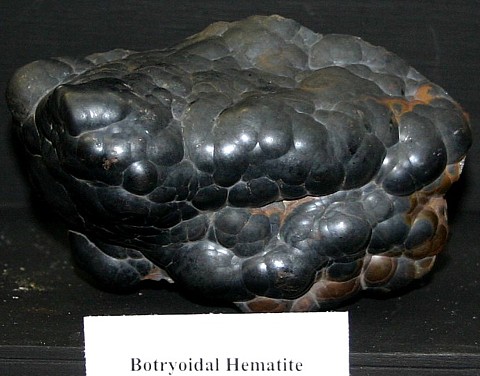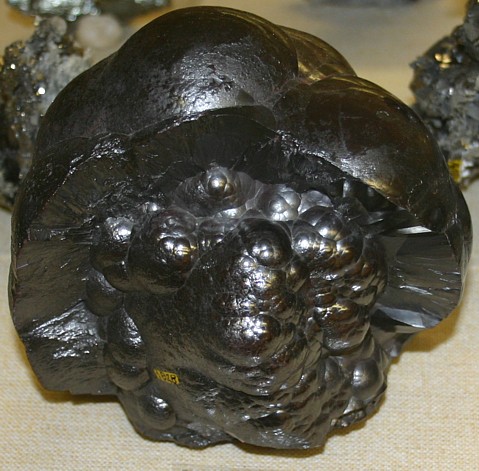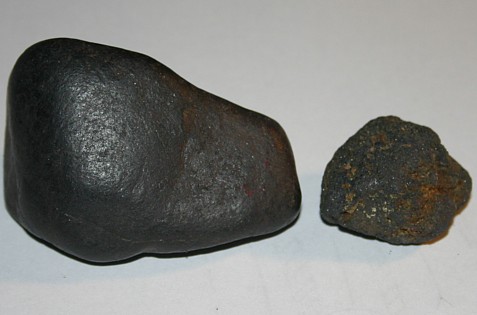Iron is, next to aluminum, the planet’s most widely distributed and abundant metal, constituting about 4.6 percent of the earth's crust. It is found native in meteoritic masses and in eruptive rocks, mostly associated with other metals e.g., nickel, cobalt, etc. Metallic iron is unaffected by dry air, but oxidizes to "rust" under the influence of moist air. Cast iron, wrought iron, and steel are the forms in which iron occurs in commerce. Their different properties are primarily due to the presence of varying amounts of carbon. Steel is again divided into several classes or grades, each named after its particular properties (mild, hard, etc.), the use to which it is put (tool steel, etc.), or the metal with which it is alloyed (manganese, chrome, nickel, or tungsten steel). These specialty steels have been found in practice to be especially valuable for different purposes, such as armor plate, guns, high-speed cutting tools, rails, springs, etc. Nickel steel is of particular importance, its tensile strength and elasticity being enormously greater than that of ordinary steel. Pig iron, from which all the various grades of iron and steel are obtained, is produced in the blast furnace by reduction of its ore by coke.
Iron only very rarely occurs native, being found chiefly in the form of oxides, sulphides and silicates. It is found in greater or less amount in many rocks, especially in those that contain the amphiboles, pyroxenes, micas or olivine. The mineral species that contain iron are very numerous but the minerals of importance as ores number only three or four. Iron occurs in large amounts in the sulphides, pyrite, FeS2, being the most common of all sulphides. These, however, never serve as ores of the metal because of the injurious effects of the presence of sulphur upon the iron. The minerals used as ores are the various oxides or the carbonate.
The chief ores of iron are the oxides: red hematite, containing 70 percent Fe when pure; brown hematite or limonite, containing 56.9 percent; magnetite containing 72.4 percent Fe; and the carbonate, siderite, or spathic iron ore, containing 48.3 percent. Magnetite of exceptional purity occurs in large quantities in Sweden, and is the source of the noted "Swedish iron.' Undesirable impurities in iron ores are arsenic, sulphur, and phosphorus, except in the case of the manufacture of basic or non-bessemer steels. Iron ores containing 30 percent Fe and upwards are profitably smelted, but the value of iron ores (in common with most other ores, of course) depends on their situation, and also on the composition of their gangue in addition to their iron content. For example, an iron ore containing 30 percent Fe, and a gangue of silica, alumina, and lime in such proportions to make it self-fluxing, may be more valuable than a richer ore containing impurities which it would be necessary to remove.
The various iron ores are formed under different conditions, and as a rule occur alone or in association with only small amounts of any one of the others. Iron is found in large amounts in many igneous rocks, some of which are rich iron ores. Some sedimentary rocks also are rich enough to mine for iron, and many rocks, sedimentary and igneous, upon weathering yield high-grade iron ores. Iron ores in the United States carry in general 35 to 65 per cent, of iron, and the larger portion of the iron ore now mined carries more than 40 per cent. The ores of iron are in the main syngenetic. Some valuable deposits, including those of the Kiruna district, Sweden, and some of the magnetites of the Adirondacks, New York, have been formed by magmatic segregation. A great many deposits in the United States are sedimentary. These include the Lake Superior hematites, the Clinton iron ores, the black-band carbonate ores, and the Tertiary ores of Texas. The rich hematites of Minas Gerias, Brazil, and the limonite-carbonate ores of Luxemburg, Lorraine, and of the Cleveland district, England, and many other regions are also sedimentary beds. Magnetite ores in several districts in Montana, Colorado, California, New Mexico, and Utah are of contact metamorphic origin. Other deposits have been formed in the deep-vein zone. Many of the hematite and limonite ores in the United States are weathered products of ferruginous carbonate or ferruginous silicate protores. Some limonite deposits are oxidation products of sulphide deposits for example, the limonites of Ducktown, Tennessee and of the Gossan lead, Virginia.
Many deposits are valuable only after enrichment by weathering. Thus the Lake Superior iron-bearing formations are all of too low grade to work except where superficial alteration has taken place. Ores of the "lateritic" or residual type like those of Cuba have resulted from the thorough decomposition and leaching of iron-rich igneous rocks, other abundant constituents having been removed in part or altogether by long continued action of air and water. Tropical conditions are favorable to residual concentration.
At some places in the West and in Mexico the gossan ores are rich enough in iron to be mined for flux. All ferruginous materials in the presence of air and water tend to change to the hydrous oxide; a steel rail, an igneous rock, a sulphide ore, or a ferruginous sedimentary rock will all yield limonite. Oxidation or weathering almost invariably results in the concentration of iron near the surface. The materials other than iron are removed more rapidly than iron, and because of their removal the iron remains in a more concentrated state. The Lake Superior ores have been formed mainly by weathering of sedimentary protores. Although iron migrates slowly under conditions of weathering, some iron is dissolved and then re-precipitated. The cementation of fractures by iron oxide, the replacement of soluble carbonates, and the development of crusts, stalactites, and stalagmites of limonite, etc., all are common processes in the weathering of most ferruginous materials.
Under some conditions great quantities of iron are transported in solution and deposited in swamps, in lakes, and in the sea. The iron is probably carried as ferrous acid carbonate. In the presence of decaying vegetation iron is reduced and tends to remain in the ferrous state. Ferrous salts are more soluble than ferric salts. From these iron may be precipitated by decarbonization, by oxidation or by other chemical processes, or through the action of minute organisms known as iron bacteria. Bog and lake iron deposits are commonly produced by the weathering of iron-bearing rocks in moist countries, and locally such deposits are mined for iron. Iron is not dissolved readily under arid conditions. Beds of salt (halite) and gypsum are commonly associated with shales and sandstones stained red with hematite. The soluble salts of iron are the ferrous salts rather than the ferric salts. In the absence of organic products that supply reducing agents the iron is likely to be oxidized to the insoluble ferric condition. Thus, in an arid region, the iron may remain as residuary masses, or if it is removed it may be transported mechanically as the ferric oxide rather than in solution as ferrous salt.
Hematite is by far the most important ore of iron, forming in the United States about nine-tenths of the ore that was historically produced. Limonite and magnetite form each about one-twentieth of the total, while the amount of siderite produced is almost negligible. Hematite ore comes chiefly from the various Lake Superior districts and to a much less extent from Alabama. Limonite is found in the Appalachian states, and magnetite in New York, New Jersey and Pennsylvania. Siderite has been obtained from Ohio. Historically, nearly one-half of the world's production of iron ore came from the United States; for many years, the amount produced from Minnesota alone nearly if not quite equals that produced in any other country. Currently, the US produces about 2 percent of the world output. In recent decades, Australia, China, India and Brazil have been the world’s largest iron ore producers. Much of that production comes from banded iron formations in Precambrian rocks.
Germany and Great Britain, Spain and France, have historically been notable producers of iron. Most iron ores in Europe require some mechanical cleaning, and in some cases electromagnetic separation is employed. Roasting or calcining is also frequently resorted to for the purpose of removing water, carbonic acid, and sulphur. Considerable quantities of the natural oxides and silicates are mined and prepared for the market, for use in the manufacture of paints, and as linoleum fillers. For example, ochres are hydrated ferric oxides; sienna and umber are silicates of iron and aluminum, containing iron and manganese; red or brown oxides are the hydrated or anhydrous oxides, or may be produced by the calcination of carbonates, whereby a wide range of shades is obtained.Return
to Metal Ores Page:
Precious and Base Metal Ores

Above: Hematite, the most common ore of iron

Hematite, N iron oxide, the most important ore mineral of iron.

Above: Magnetite, a less common ore of iron
